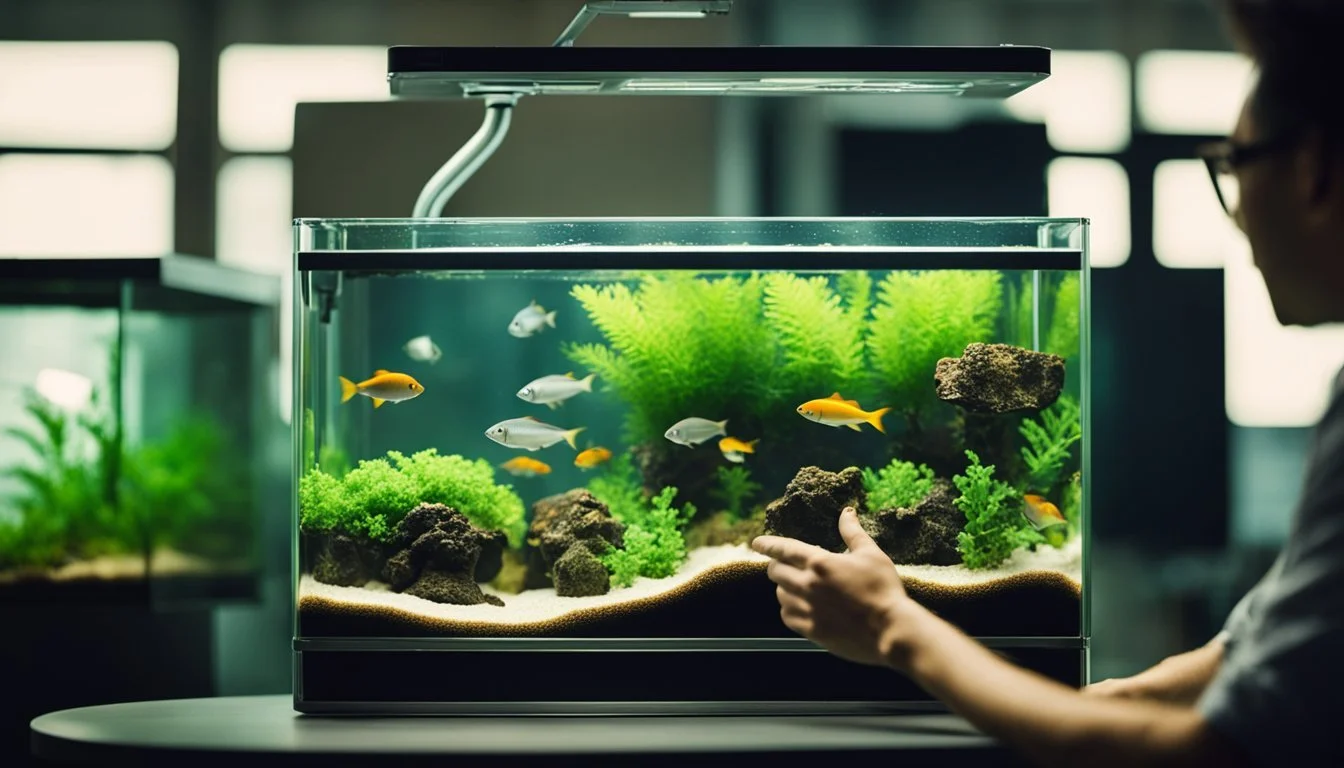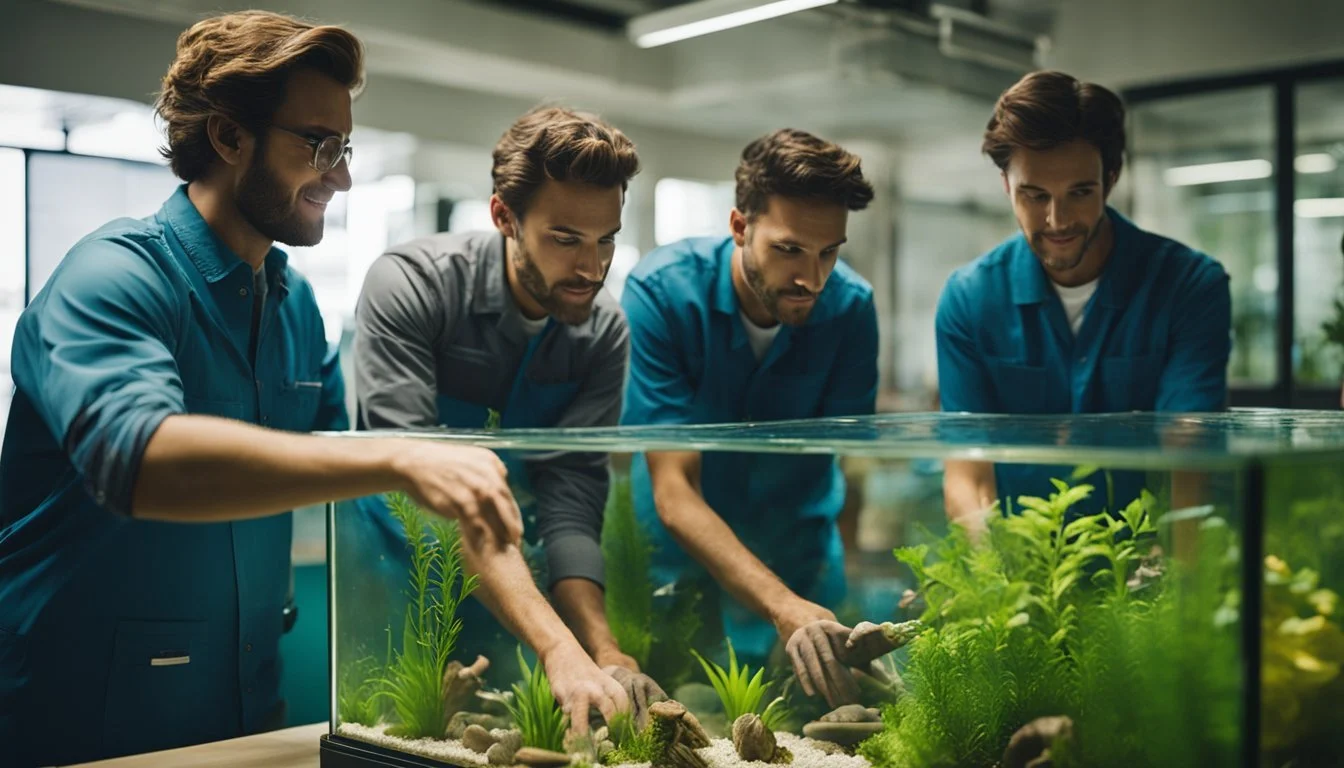How to Move to Austin with a Fish Tank
Expert Tips for a Smooth Transition
Moving to Austin can be an exciting adventure, especially if you're a fish enthusiast planning to bring your beloved tank along. Relocating a fish tank requires careful preparation and precise methods to ensure the safety of both your aquatic pets and the tank itself. Safely transporting fish involves transferring them into oxygenated holding containers and packing the tank securely to prevent damage.
Start by removing the fish from the tank and placing them in temporary containers with oxygenated water. Siphon out the remaining water into buckets and carefully collect the substrate from the tank bottom. It's important to pack the fish tank with foam board insulation and air-filled plastic padding to avoid glass breakage during transit.
Make sure all accessories and equipment are wrapped in packing paper and stored in cardboard boxes. Before moving day, check that the new location in Austin is ready with appropriate water conditions and temperature. With the right preparation, you can ensure both a smooth move and a thriving new environment for your fish.
Pre-Move Planning
Effective pre-move planning is essential for relocating a fish tank to Austin. It involves creating a detailed checklist, selecting the best moving services, contacting professional movers, and understanding the intricacies of fish tank transportation.
Creating a Moving Checklist
Creating a detailed moving checklist is the first important step. This list should cover all tasks from initial preparations to unpacking in the new location. Essential items include acquiring packing materials like foam board insulation and air-filled plastic padding, and noting key responsibilities such as draining the tank and safely storing fish. By listing tasks, you ensure nothing is missed, and the move proceeds smoothly.
Selecting the Right Moving Services
Not all moving services can handle delicate and complex items like fish tanks. You need to select a service that has experience with fragile items. Some moving companies specialize in transporting sensitive items, including fish tanks. Confirm that the movers use appropriate packaging techniques and provide customizable moving solutions tailored to these specific needs.
Contacting Professional Movers
Contacting professional movers should be done early in the planning stage. Discuss the specifics of your fish tank, including size and contents, and verify their experience with such moves. Professional movers can offer advice on the best practices for packing and transporting your fish tank and may also provide specialized equipment or services needed to ensure the safety of your aquatic pets.
Understanding Fish Tank Transportation
Understanding the complexities of fish tank transportation is vital. Fish tanks must be drained, and fish should be transferred to suitable containers with adequate water and oxygen supply, like buckets with air pumps. Additionally, the tank should be packed with materials like towels or packing paper and insulated with foam boards. Familiarizing yourself with these steps helps prevent damage to both the fish and the tank during the move.
Packing Your Aquarium
Successfully packing your aquarium involves gathering the right materials, safeguarding delicate equipment, and preparing containers for safely transporting fish and plants.
Acquiring Packing Supplies
To start, gather essential packing supplies. Bubble wrap, foam board insulation, packing tape, and sturdy boxes are crucial. Use bubble wrap to cushion the glass tank, wrapping multiple layers for extra protection. Foam board insulation lines the box, providing a protective barrier between the aquarium and the box itself.
Include packing paper or towels. These help fill the tank and prevent movement. Ensure all materials are of high quality to protect the aquarium and any fragile item during transit.
Protecting Fragile Equipment
Aquarium equipment is often fragile and needs careful handling. Begin by unplugging and cooling the heater for 30 minutes before packing. Clean it to remove algae and mineral deposits. Secure it in bubble wrap and place it separately in the box.
Filtration equipment and circulation pumps should also be cleaned and dried before wrapping. Label these items and pack them in separate, well-cushioned boxes. This ensures that each piece is protected and easy to locate and reinstall at the new location.
Preparing Transport Containers
Prepare special transport containers for the fish, plants, and water from the tank. Use strong, airtight containers for water to maintain the current environment, which helps reduce stress on the fish. Fish should be placed in separate transport containers, ideally those that ensure adequate oxygenation for the journey.
Plants need water-filled containers to keep them moist and healthy. Label these containers for easy unpacking. Ensuring that all living inhabitants have safe, temporary homes will facilitate a smoother transition upon arrival.
Fish and Plant Care
When moving a fish tank to Austin, ensuring the well-being of both fish and plants is crucial. Special attention to stress prevention, safe handling of plants, and maintaining water quality can mean the difference between a smooth transition and a distressing experience for pets.
Stress Prevention for Fish
Fish are sensitive to changes in their environment. To minimize stress, gradually acclimate fish to any new conditions. Start by placing them in temporary containers filled with tank water.
Ensure these containers are secure and aerated to keep the fish safe during transit. Insulate the containers to maintain a stable temperature. If moving long distances, pack the fish in insulated fish bags with adequate air and place them in a cooler or insulated box.
Reintroducing fish back into the tank should be done slowly, matching the new tank water temperature to the temporary container's water.
Safe Handling of Aquatic Plants
Live plants need careful handling to avoid damage during the move. Start by trimming any dead or excess leaves. Carefully remove the plants from the substrate, making sure to retain as much of the root system as possible.
Wrap the roots in wet paper towels to keep them moist. Place each plant in a plastic bag with a bit of tank water to create a humid environment. During transport, store the bagged plants in a cooler to maintain temperature and humidity.
Upon arrival, quickly replant them in the tank, ensuring they are secured and have enough light and nutrients.
Maintaining Water Quality
Maintaining water quality is critical to the health of your fish. Before the move, perform a partial water change to reduce waste and toxins in the tank water. Transport some of the original tank water in clean, sealed containers to help preserve the established bacteria culture.
Upon arrival, test the water for pH, ammonia, nitrite, and nitrate levels. Use water conditioners as needed to treat the new water before reintroducing it to your aquarium. Gradually mix the old tank water with new water to help fish acclimate without shocking their system.
Ensure the filtration system is promptly set up and functioning to stabilize the aquatic environment. Use a trusted test kit to regularly monitor the water parameters during the first few weeks after the move.
Disassembling the Aquarium
Moving to Austin with a fish tank involves carefully disassembling it to ensure the safety of the tank and its residents. The process includes draining the tank, packing decorations and substrate, and proper equipment storage.
Draining the Tank
Begin by turning off and unplugging all equipment to ensure safety. Using a siphon hose, methodically drain the water from the tank into a large bucket. This helps in efficient water removal and minimizes mess.
It's essential to leave a small amount of water to keep the substrate moist, preserving beneficial bacteria. Next, gently capture and transfer the fish into a separate container filled with tank water to reduce stress. This container should be well-aerated and securely covered.
Packing Decorations and Substrate
Once the tank is mostly drained, remove all decorations such as rocks, plants, and other items. Place these in another bucket filled with tank water to keep them moist. This helps in maintaining the beneficial bacteria present on these surfaces.
Gravel, sand, or other substrate materials should be carefully scooped out with a sieve or colander. Rinse the substrate under running water to remove any debris or waste. Allow the substrate to air dry before packing it into labeled bags for transport. Using a mild detergent-safe container is advisable to avoid contamination.
Equipment Storage
Properly storing equipment is crucial. Start by turning off the heater and allowing it to cool completely before unplugging. Wrap the heater in bubble wrap or a towel and secure it in a box labeled "fragile." Repeat this process for the filter, ensuring it is dry and wrapped securely.
Lighting fixtures should be carefully disassembled, with bulbs stored separately to avoid breakage. Remove any additional equipment like air pumps and place them in protective wraps. Ensure all items are dry to prevent mold during transport, and pack these items in a sturdy box for safety during the move.
By following these steps, you ensure a safe disassembly of your aquarium, facilitating a smooth move and easy reassembly upon arrival in Austin.
Ensuring Safe Transportation
Successfully moving a fish tank to Austin requires proper preparation, storage, temperature control, and securing the tank and accessories.
Utilizing Proper Storage for Fish
It is crucial to preserve the well-being of fish during transit. Fish can be placed in plastic bags filled with the tank's original water, leaving some air inside for oxygen. Alternatively, 5-gallon buckets with lids and an air pump provide a more stable option, particularly for longer distances.
An insulated container helps maintain water temperature and reduces stress on the fish. When using buckets or bags, it’s vital to secure them within the vehicle to prevent shifting and spills. Labels indicating "live fish" can also alert movers to handle with care.
Temperature Control During Transit
Maintaining the right temperature is essential for fish health. Before moving day, prepare by having a heater or temperature control system in place. During travel, an insulated container helps to stabilize the temperature. Portable heaters or even heat packs can be used in colder weather.
Monitoring the temperature is critical. Ensure the vehicle's environment aligns with the fish's needs, avoiding exposure to extreme temperatures. Check the water temperature periodically and make adjustments as needed to prevent any sudden changes that might shock the fish.
Securing Tanks and Accessories
To prevent damage, carefully dismantle the tank and pack it. Wrap the aquarium in air-filled plastic padding and place it in a sturdy moving box with foam board insulation on all sides. Fill the tank with towels or packing paper for added protection.
Transporting the tank requires it to be level. Using a dolly or cart can help in moving it without causing undue stress on the glass or acrylic. Free-standing items like pumps and heaters should be wrapped separately and securely packed to avoid breakage.
During the move, place heavier items at the bottom and ensure everything is tightly packed to limit movement. Proper labeling and careful handling will further safeguard the tank and its accessories.
Reassembling the Aquarium in Austin
Relocating with a fish tank involves several critical steps to ensure the safety and health of your fish. This section covers setting up the tank, cleaning and reintroducing decorations, and restarting the aquarium systems.
Setting Up the Tank at the New Location
Upon arriving in Austin, TX, the first step is to identify a stable and sturdy location for the fish tank. Place the stand on a level surface and ensure it can handle the tank's weight.
Next, carefully unload the tank and position it on the stand. Fill the tank about halfway with either the preserved aquarium water or prepared water treated to match the original tank conditions.
Arrange any essential equipment like heaters, thermometers, and lights, but don't plug them in yet. Make sure all seals and joints are intact to avoid leaks.
Cleaning and Reintroducing Decorations
Before reintroducing decorations, clean them using tank water to remove any debris accumulated during the move. Avoid using soap or chemicals to prevent harming the fish.
Inspect decorations and plants for damages. Place larger rocks and structures first to provide stability for other items. Next, add plants, ensuring they are securely anchored in the substrate.
If you have live plants, plant them carefully to minimize root damage. Use the fish net to handle delicate items. Maintain a layout similar to the previous setup to reduce stress on the fish.
Restarting the Aquarium Systems
Reinstall the filtration system, ensuring filters are clean and functioning correctly. Attach any air pumps and make sure hoses and connections are secure.
Gradually fill the tank with the remaining water, taking care to avoid stirring up the substrate. Plug in and test all electrical components, such as heaters and lights, to ensure everything operates properly.
Monitor the temperature and water parameters closely. Finally, reintroduce the fish using a fish net, adding them back gradually to reduce stress. Keep an eye on their behavior to ensure they are adjusting well to their new environment in Austin.







